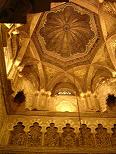The Mosque - Cathedral of Cordoba (***)
Cordoba Info
Cordoba Hotels
Restaurants
Food
Photos
Map
History
Monuments
Museums
Festivals
Events
News
Weather
Practical Info
Tips for visitors
Spanish courses
Province
About us
Email
See Also: Mosque Visitor Guide | Photos Mezquita Exterior | Photos Mezquita Interior
Mezquita general description and historical notes
The Mosque of Cordoba was built during the 9th and
10th centuries and consecrated as the cathedral in 1236. A Jewel of Hispano-Islamic
art, the Mezquita, with its 850 columns, double arches and Byzantine mosaics,
is a legacy of the Ummayid Caliphate in Spain. In the center of its vista
of columns rises a 16th-century cathedral.
The Great Aljama Mosque of Cordoba, begun in 786 by Abd al-Rahman I, is the highest expression of Islamic art in Spain and the most important historic mosque of the West. Its last touches were made by Almanzor in 988, and it was the place of worship for the rulers of the western Islamic empire Al-Andalus.
Important Islamic features include the Minaret, now enclosed and reformed into a Baroque bell tower, the Orange Tree Courtyard, the Mihrab and the forest of columns and arches.
Abd al-Rahman I purchased the land for the mosque, destroying the Visigothic monastery of San Vicente and using its columns and capitals, along with columns brought from elsewhere. Recently, part of the floor of the 5th-century San Vicente church has been revealed for viewing. Before the existence of the monastery, there had been a Roman temple dedicated to Janus on the site.
When Fernando III conquered Cordoba in the 1236, the Mosque was consecrated as a cathedral. In 1523, the cathedral canons ordered the center of the mosque pulled down to make way for a Gothic transept and apse, later embellished with Renaissance decorations and, in the mid-18thC, Baroque choir stalls and pulpits.
Christian conversion of the building to a cathedral may be responsible for its excellent conservation. Other important monuments in the city were plundered for their marble, cut stone and columns over the centuries, and no other mosque survived intact. Not everyone in 16th-century Cordoba was happy about the proposed changes to the Great Mosque, however, and there was a legal battle between the church and the city hall, which the king resolved in the church's favor. Nevertheless, when Charles V visited Cordoba and saw the the monument which his local authorities had tried to preserve in its original state, he declared "You have destroyed something unique to make something commonplace".
Although the gothic cathedral and its butresses occupy the center of the former mosque, large expanses still remain much the same as they were in the 11th century Ummayad Caliphate.
about us | disclaimer ©2005-2014 Tony Reed




